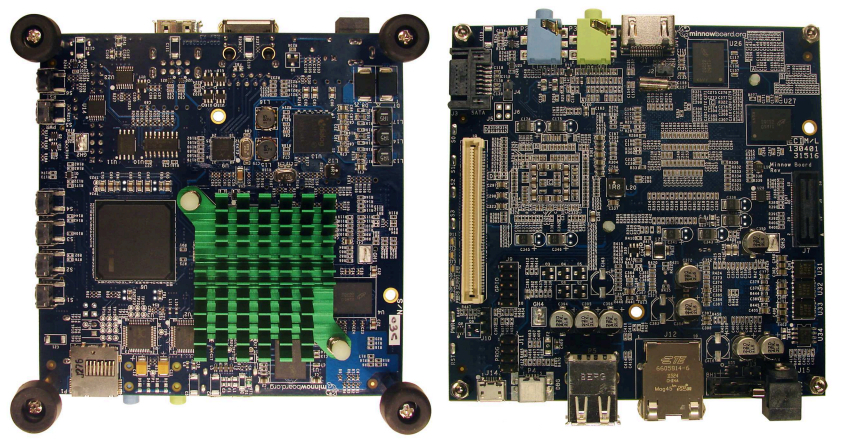Intel Ships its First Open-Source $199 PC

The MinnowBoard community website reports that Intel is now shipping its MinnowBoard bare-bones PC. It's a bit heftier in price than the Raspberry Pi, costing $199 USD, and can be purchased at Digi-Key, Farnell, Mouser Electronics and Newark. Additional outlets will be added soon.
Intel's MinnowBoard sports an Atom E640 SoC clocked at 1 GHz, integrated GMA 600 graphics, 1 GB of DDR2 RAM, and 4 MB of SPI flash for system firmware memory. The I/O portion contains one microSD card slot, one SATA 2 (3 Gb/s) port, two USB host ports, one microUSB-B port, a serial (UART 0) port for debug serial to USB conversion, a Gigabit Ethernet port, and HDMI output.
The board's "experimenter" features include eight buffered GPIO pins, two experimenter GPIO controlled LEDs, four experimenter GPIO switches, and a system firmware flash programming header (Dedi-Prog compatible). The board boots using open-source UEFI firmware with Fast Boot capability, and the shipped OS of choice is the Angström Linux distribution, which is compatible with Yocto Project.
The board's actual dimensions are 4.2 x 4.2 inches, and can be expanded using daughter cards called "Lures." These cards can be custom developed to "expose features and interfaces as required for developer applications." Lure specifications for the MinnowBoard can be found here, and includes an Automotive Lure and a MiniPCIe/mSATA Lure.
A joint project with CircuitCo Electronics, the MinnowBoard is Intel's first "open source," bare-bones PC aimed at software developers. It's also supposedly the first of its kind to ship with an x86 chip on-board. Price wise, it's closer to some of Zotac's solutions than Raspberry Pi or Arduino, but that could change if units aren't flying off the shelves of the retailers mentioned above.
"Where the MinnowBoard really shines is in its I/O performance," said Scott Garman, embedded Linux engineer at Intel’s Open Source Technology Center. "Powered by PCI Express, you can make full use of SATA disk support and gigabit Ethernet for high throughput applications such as file servers or network appliances."
Intel has several guides up on the MinnowBoard website including an introduction that takes users from unboxing to booting up the OS, toggling one of the two LEDs from the Linux command line and GPIO programming. These are currently in PDF format and will supposedly see HTML-based versions in the near future. The board's schematics and design are also published under a Creative Commons license.
Get Tom's Hardware's best news and in-depth reviews, straight to your inbox.
To get involved with the MinnowBoard community, head here. The board is available now for $199 at Digi-Key, Farnell (UK), Mouser Electronics and Newark.

Kevin Parrish has over a decade of experience as a writer, editor, and product tester. His work focused on computer hardware, networking equipment, smartphones, tablets, gaming consoles, and other internet-connected devices. His work has appeared in Tom's Hardware, Tom's Guide, Maximum PC, Digital Trends, Android Authority, How-To Geek, Lifewire, and others.
-
WithoutWeakness This is a cool little board, though I think the price is a bit high compared to RPi (likely it's biggest competitor). The inclusion of a SATA port and gigabit ethernet are definitely solid features to have and building a board like this around an x86 chip should shake the market up a bit.Reply -
cRACKmONKEY421 I'd like to see how this $200 1ghz atom based board compares with the $200 1.7ghz atom based netbook I bought three years ago. Maybe someone will do something cooler with this thing though. I guess it's all about the "experimenter" features.Reply -
The_Trutherizer The price is high simply because of the fact that it is an SoC. This chip probably costs Intel less than $10 a pop to manufacture. And after an extremely toned down motherboard the rest of the price can only be development costs and then profit. I feel this is way overpriced. I suppose there is a bit of risk for them since they cannot just sell a ton of SoCs to a supercomputer building company for 50c a pop to recoup costs if the board does not sell.Reply
It's nifty don't get me wrong, but it really is just a bit overpriced. -
Steveymoo I doubt SATA 2, and 10GB ethernet are really necessary, since a 1GHz atom will not really be up to the task of maxing them out.Reply -
cypeq Reply11273292 said:I doubt SATA 2, and 10GB ethernet are really necessary, since a 1GHz atom will not really be up to the task of maxing them out.
not as DB Server but as filisharing device why not ? and it's 1GB ethernet.
-
mynith You can have an APU for that money. Ok, yes, the gpio-pins are neat, and it is quite tiny which is great, but it doesn't have to be this expensive, considering the performance. In fact, if I wanted a really small x86 board, I'd see what VIA has on offer first.Reply